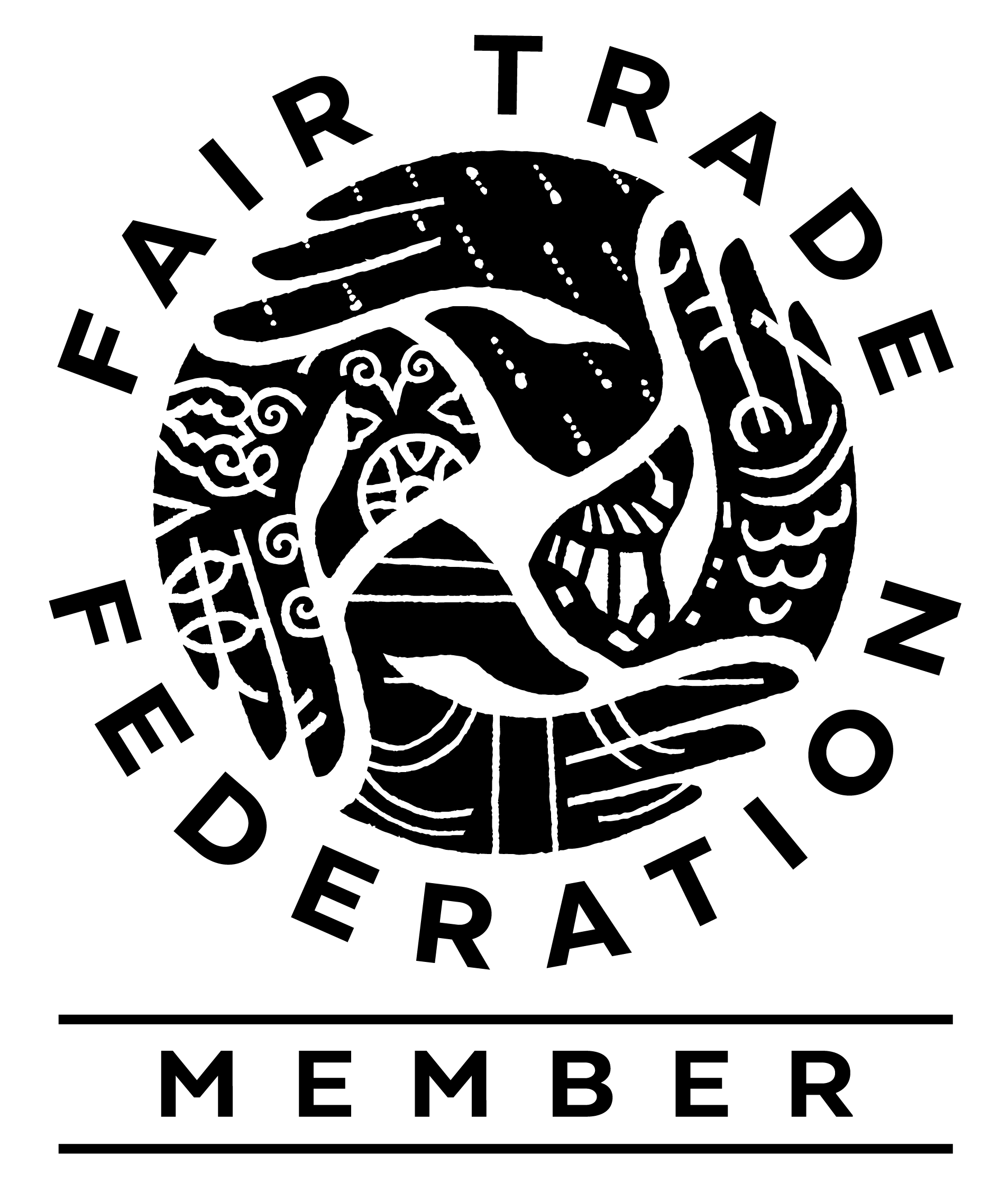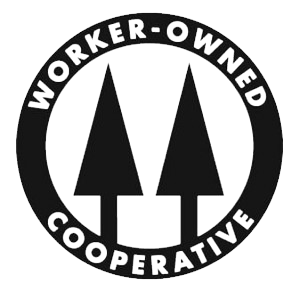
By Frankie Pondolph and Danielle Robidoux, Action Forum Organizers
Since the creation of Equal Exchange 32 years ago, people and relationships have always been at our center. Coffee, chocolate, tea, mangoes, cashews; these are the mediums which allow us to show the world that ethical supply chains are viable and that there is more than one way to do business. Radicalism lies within the Equal Exchange model: a supply chain that is characteristic of true democracy, cooperative learning, transparency, and respect for our planet and its people.
We at Equal Exchange have supported our producer partners abroad and have stood alongside them in their struggles to build a more sustainable trade system. We have intentionally committed time and resources to strengthening our internal democracy as a worker co-op. As we reflect on the organization and the model we have built; and the complexities that now define our world; we have come to realize that there is a missing piece: you. This insight led us to create the Equal Exchange Action Forum.
In an attempt to build a democratic food system which is truly transformative, it is not enough to focus on the buying and selling of a product; likewise, for true change to occur, involvement can not begin and end with a purchase. Voting with your dollar is not enough. Democracy takes effort, commitment, collective responsibility, and passion. It is not always easy; is definitely not straightforward; but it is necessary, if we want to create a better world.
The Action Forum is an initiative through which we invite individuals to participate in our organization; more deeply than ever before. This process has been fluid and malleable. We are trying to find better ways to carry out our work; to be transparent and authentic about our successes, weaknesses, challenges, and visions. To do this, we hope to build a group of active participants who will do this work alongside us. In short,we want to change our way of doing business. Again.
This past year has been one of learning, connecting, and discovering a shared community and culture within the Action Forum group, now comprised of 4,000 people across the U.S. and abroad. We have gathered in breweries and shared a beer; convened in churches; presented in community spaces; had round-table discussions at food cooperatives; organized potlucks; and even sipped espresso with members at their kitchen tables. Our team has gone from the East Coast to the West, and many places in-between. About 20 face to face meetings and 25 webinars, we are grappling with the complexities of our food system and beginning to formulate innovative solutions, together as a community.
2017 was our launch year, a year of learning, engaging, experimenting and building a global community. As an Action Forum team, we got to travel to new places, meet amazing people that were really engaged within their communities and shared moments of inspiration and difficult realities facing the future of food, and the need to elevate the stories of it all. From the stark realities of climate change affecting our producers partners, to political strife, and price and market conditions consolidating – we have just started to thread together the alternative systems and creative thinking to combat these challenges, as an Action Forum community. We learned about supply chains, shipping, price, access and through this had moments of joy, laughter and challenging moments of realizing the heaviness and complexity of growing, buying, selling, and consuming food.
One of the biggest pillars of our work is hosting annual summits- you may remember reading about our first-ever People’s Food Summit hosted last year at Stonehill College and on June 8th of this year we brought together over 100 individuals representing all parts our supply chain: Equal Exchange worker-owners, producer partners, and allies, together with our Action Forum members. As a community, we seek to offer spaces to grapple with many food industry dilemmas and ways we could imagine building a better food system, together.
We are gearing up for for our second summit of the summer next week on July 7th and 8th in Chicago, held at Loyola University’s Water Tower campus. This summit is bringing together keynote speaker Silvia Roblero Torres, sales and certification manager of CESMACH our coffee cooperative partner in Chiapas, Mexico. Workshops from Professor Phil Howard a professor at the Department of Community Sustainability at Michigan State University and a member of the International panel of experts on Sustainable Food Systems, Pushpika Freitas founder of MarketPlace of India an Alternative Trade Organization founded in the 1980’s working with small farmer textiles and Jeff Heinen a third generation owner of Heinen’s Supermarkets a family grocery store, as well as the directors of Equal Exchange, Rob Everts and founder Rink Dickinson.
Please fill out the short application to stay connected and RSVP to our summit here.
Want to get in touch? Reach out to us at eeactionforum@equalexchange.coop
Sweet Tea is the summer drink of choice across the American South. As the days heat up, it’s time to get your tea game on-point!
EE Sales-Rep LeeAnn Harrington is a professionally trained chef. In Texas, where she hails from, folks sip their iced tea without sugar. But during the five years LeeAnn spent in Orlando, FL studying at LeCordon Bleu, she developed a sweet tooth and learned to drink Sweet Tea like a local.
Chef LeeAnn is a perfectionist; when we asked for Sweet Tea tips using fairly-traded teas, she told us she’d have to experiment a bit. She’s been interested in the science of cooking since childhood, when she made her first pudding from scratch, marveling as the ingredients thickened from a watery liquid to a rich, velvety texture.
True to form, Chef LeeAnn tweaked her Southern Sweet Tea recipe until she achieved just the right blend of flavorful and refreshing.

Here are Chef LeeAnn's instructions for black tea, green tea and herbal tea. Try all three versions for peak summer chill!
Combine the granulated sugar with two cups of water in a medium-sized saucepan and heat over medium heat, stirring continuously with a large spoon until the sugar is completely dissolved. Set aside to cool.
Over medium heat, bring another saucepan with four cups of room temperature water to 212 degrees F, or just to boiling, (not a rolling boil).
Remove from the heat, and place the 6-8 bags of tea in the saucepan. Cover with a lid and let the bags steep for 4-5 minutes.
Remove the tea bags and let the brewed tea cool to room temperature. Leaving the bags in for much longer than five minutes can result in a bitter taste!
When both mixtures are at room temperature, combine them in a gallon size container and add the remaining 10 cups of water.
Place in the refrigerator for at least eight hours to allow the tea to cool sufficiently.
Variations on this theme:
Try substituting Equal Exchange Organic Green Tea! Bring the water to boil, then let cool to 170-180 degrees and steep for just 2-3 minutes before removing tea bags and continuing with the recipe as written above. Or use a caffeine-free Organic Herbal Tea from Equal Exchange such as Rooibos, Peppermint, Ginger or Chamomile. Bring the water to boil, 212 degrees F. Immediately add teabags, but steep for longer, 8-10 minutes.
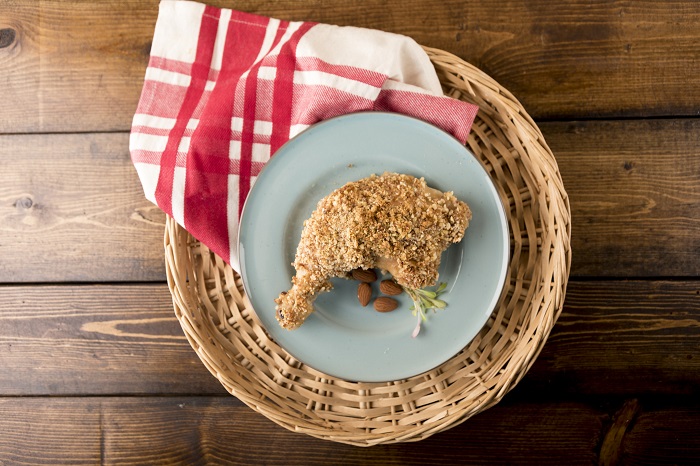
Fairly traded and organic almonds give this crispy chicken dish extra texture and a mildly sweet, nutty flavor, complimented by black pepper and paprika. Our Almond Crunch Chicken recipe is just as easy to make gluten-free. Grill it or bake in the oven for a crowd-pleasing summer recipe.
Enjoy!
Hungry? Read more picnic recipes!
Want to receive more news and ideas for fairly traded products? Sign up for our newsletter!

Recipe courtesy of PARC.
Anticipating of the arrival of the Palestinian Farmer’s Box, we were excited to try this flavorful za’atar potato salad. It’s a zesty alternative to traditional mayo-heavy potato salads, made with za’atar, a savory Middle Eastern spice mix of fragrant thyme, sumac and sesame seeds. We added Equal Exchange’s Palestinian Virgin Olive Oil to the recipe for an extra punch of flavor and fair trade goodness.
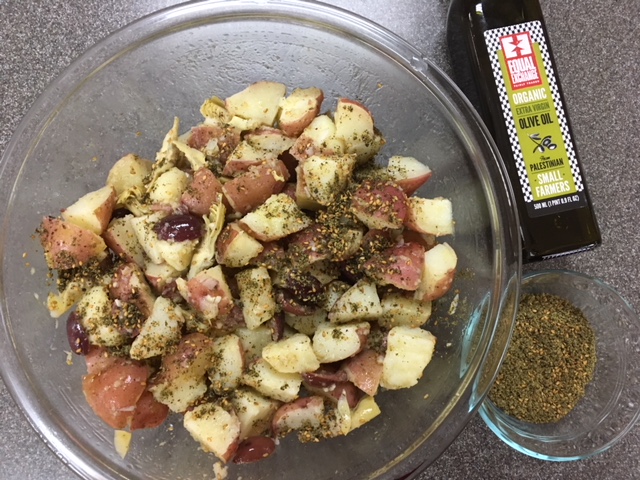
Adapted from “The Local Palate” recipe by Matt Moore.

Hungry? Read more picnic recipes!
Thank you for signing up for our newsletter!
Do you enjoy a hot cup of coffee in the morning as much as we do? Do you love red meat? Then you’ll flip for our BBQ Spice Rub recipe.

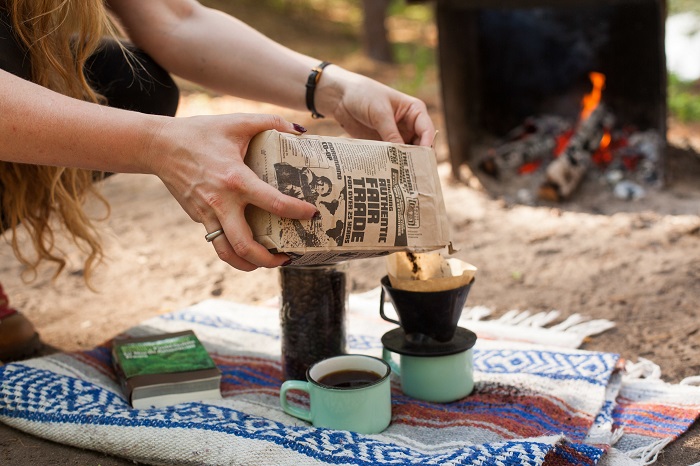
Hungry? Read more picnic recipes!
Thank you for signing up for our newsletter!
One of the challenges of worker coops, consumer coops, and producer coops is how to reconcile two competing high level goals. On one hand most of these coops have an economic,organizational, and service mission. In the case of a consumer coop the mission is to serve the members, which translates to goals such as good and affordable food. In the case of a producer coop the goal is higher prices, while in a worker coop the goal could be rewarding and economically sustainable jobs.The competing goals are to run the organization democratically, where members participate in some type of joint democratic development and learning process.
It seems that most of the engaged coops are more complicated, not to mention the competing goals of economics and service versus democratic development. Most food coop have mission statements that will go beyond good and affordable food to goals such as supporting local producers, building a cooperative network, and moving towards greater food justice.The Equal Exchange mission is global and is about connecting US consumers with small farmers and demonstrating the viability of fair trade and worker coops.
Ignoring the layered complexity in the missions of many producer, worker and consumer coops, let’s return to the challenge of delivering benefits to members and the goal of living as a democratic/learning/mistake-making organization.
The United States at large and democratic countries in general are failing at learning, practicing, and building democracy. This failure of the last forty or fifty years has now reached the point where democracy itself as a value and a process is being openly sabotaged. This attack on democracy is very present in the US, but also in most countries that are more or less democratic. A short list of these countries would include France, the UK, Germany, India, and Brazil. Defending, developing, and creating political democracy in these democratic countries is becoming the great political challenge of this time.
My thesis here is that there is a connection between the challenges that democracy is facing on a political level in our democratic countries, and the problem democracy faces in our cooperatives. For democracy to function there has to be community engagement, dialogue, risk, learning, and some ability to learn from failure and success. There has to be participation, communication, and respect. The mix of risk, learning, failure, success, and starting that process over again is very fragile. The process and the results have to be considered fair and meaningful to the participants.
We are all experiencing the challenges in our political system. Participation in the US is too low and many people believe there is no reason to participate. There is an overt strategy to reduce citizen’s participation particularly directed at racial minorities.Communication, respect, and support for minority views is being greatly reduced. In this environment it is harder to obtain healthy learning, or understanding of success and failure which is vital to society progressing.Ultimately,the political process in most of our democracies is becoming weaponized between parties/interest groups and has become a fight for winning and little else.
In our worker, consumer, and producer coops the democratic dilemma plays out differently but the underlying processes are similar. The greatest threats to our nominally democratic coops are these:
Too little organizational success- picture a consumer or producer coop that is small, economically struggling and just doesn’t have enough members, capital, or capacity, and is weak economically. This type of organization does not deliver enough benefits to its members, is too marginal in terms of resources and capacity to work that well. Perhaps there is a culture of caring and sacrificing for this type of coop organization for a medium or long period but the risk of social fracture, anti-social fighting, poor management, poor board leadership is also quite likely to be part of the culture as well. Ultimately, these organizations are under extreme threat because they struggle to develop to a place where they can deliver benefits to their members. They are often at very high risk of destructive democratic conflict as well.
Too much organizational success- it seems odd to argue that success would threaten a cooperative organization. Possibly success in and of itself is not the problem. It is when economic success is present, but meaningful democratic control is not generally present or not really possible. My image here is coops that are ossified become coops in the name only. I am thinking of large agricultural coops that have been around for 50 or 100 years.They might be economically large, perhaps economically successful, but operate just like an average corporation. The democratic control of membership is long past and is basically there in form only. The messy issues of minority viewpoints, investing in democracy, and making good and bad democratic decisions are long gone.The worst form of this type of coop is one in which members are members in name only. The very worst situation is one in which “members” are coerced participants with no options but to sell to participate with no control whatsoever over “their” coop. An example of this is many large scale dairy coops in the US, which have delivery vehicles to isolated farmers to offer prices below the cost of production.
Too little democratic process- this often pairs up with coops that are economically successful but it doesn’t need to. How do we know when our democratic coops are keeping and building their democratic culture? How many high level decisions do members make and how often? If you are a farmer in a dairy coop in the US, or in a producer coop in Guatemala, or a coffee coop in Nicaragua, or a tea coop in South Africa how much involvement is the right level? That question applies to consumer and worker coops as well. Scale compounds these issues. To be economically stable it often makes sense to be larger. Being larger requires all kinds of skills which make the organization more complex which require skill and specialization. The larger scale and specialization in itself weakens commonality and group learning on successes and failures. It is easy to see an economically successful coop slowly, unconsciously evolve into an organization with little real democratic process, learning and decision making. Even in well intentioned situations what can result is the structure of democracy (well the board is elected by the members of this good sized entity and therefore we are passing as a democratic organization) with no democratic culture, or muscle.
Too much democratic process/destructive democratic process- again the problem here might be too much process or it might be an unskillful or destructive democratic process. Democracy is risky. We will make mistakes. The goal is to keep making decisions and mistakes but to avoid destructive, brutal, internecine, cooperative warfare. Every one of our genuinely democratic coops is at some risk of being brought down by highly destructive conflict through the needed democratic process. There is a direct relationship between the problem of too much democratic process and too little democratic process and this is where management and the board come in. As coops live through near death experiences from too much democratic process/destructive democratic process a lesson learned can often be to not put the organization at that risk again. Our very democratic structure and democratic participation can destroy us. So perhaps the solution appears to be to avoid those risks altogether (which might be sort of correct) but the way to do that is do avoid all large, unclear issues getting in front of membership (which is incorrect). The contradiction is ultimately if the membership doesn’t debate, decide, or learn together that the coop is on the path to losing its culture and raison d’etre. Perhaps ten or thirty years later the coop will become an economically viable organization but not really a coop.

Just to be in the market is risky. Most of us don’t really like risk. We must choose between unpleasant options all the time. A large part of that process requires solid management.
Building democratic coops also is in itself risky. We can only learn by making mistakes and learning. Meaningful large scale decisions need to be in front of membership with enough frequency for the coop as a whole to learn and advance. This group learning, struggle, and solidarity is the essence of what we are building. It is extremely challenging for membership, board, and management to build the skills to artfully negotiate the dilemma of which decisions should or should not go to membership. Usually there is no roadmap. What looks like an interesting vital issue to one person or group of people might look like the shadow of the real issue to another person or group. There is no right answer, but there is risk and danger nevertheless. Ultimately we need to learn the skills of managing democracy and communication while also learning the more standard skills of running an effective organization
above: Gary Goodman with his father.
Is your dad a coffee lover, a brewing geek, or the kind of guy who takes his daily dose of caffeine like medicine? No matter what his blend, you can help him get the best out of his morning ritual this Father’s Day. It’s a way to say: “Thanks for being there for me, over the years!” We’re excited to share our line of single-origin coffees and our manual brewing tips, below.
On a day that celebrates relationships, the most meaningful gift can be time spent in appreciation. If your father’s around, that might mean a slow cup of coffee with him and a heart-to-heart. Or maybe you’ll just take a moment to acknowledge the role-model — dad, stepdad, relative or friend — who helped shape you.
As Father’s Day comes around each year, it reminds me of something I learned from early on; family, the one you’re born into and the one you build, is one of the most important parts of life.
Family has a huge impact on the opportunities afforded to you, the degree of love and security you feel while growing up, and is a great source of joy and sorrow. On Father’s Day, I remember the incredible impact my dad had on me. He taught me how to work, how to play and how to love. He taught me to put family first, and that as you build a family of your own, that sometimes you need to make personal sacrifices to keep the family strong. The memories that are most vivid for me are the times I spent with my father one-on-one. When he asked me about my life, provided gentle guidance and fatherly wisdom. It is in these moments, these memories, that the true essence of what Father’s Day is materializes for me.
As I have grown older, and become a father myself, I have gained new insight into fatherhood and a new understanding of my own father. When I think about what I want out of Father’s Day, it isn’t a new tie, a case of beer or some other material object. What I want to give, and to receive, is time. Time to talk, to connect, and to make memories with the ones I love and who love me. So as you ponder what to do for Father’s Day this year, remember what truly matters; a chance to remember those special moments with your dad, and if you’re lucky, to make some new memories in the year ahead.
Let’s face it. Everyone’s dad is unique — and so are our single-origin coffee beans. Each has its own particular aroma, flavor and aftertaste. Explore the full selection and find the perfect brew for your dad.
Looking to spice up the morning coffee ritual, and put a little extra hair on his chest? If he isn’t already into manual brewing, Father’s Day could be the perfect opportunity to introduce a new way to brew. Read and watch Equal Exchange Coffee Quality Coordinator Mike Mowry’s tips for brewing the perfect cup in his comprehensive, step-by-step guide.
In early spring, gardeners in the USA welcome warmer weather by pouring over our seed catalogs, readying the soil in our plots, and starting plants indoors. By June, we’ve moved those seedlings outside. We’re beginning the rounds of weeding and watering that will lead to bountiful harvests in the summer and fall. If gardening’s your hobby, burying your fingers in the damp, rich soil (and later, scrubbing that dirt out from under your fingernails!) can help you feel a connection to the people who grow coffee.
Across the world, coffee farmers are hard at work, too. But Coffea arabica has a multi-year growth cycle. Its rhythm of cultivation is different from the vegetables we’re used to tending. A tomato or zucchini plant bears fruit all summer before dying. We save its seeds or buy new ones next year. Farmers who grow coffee invest more deeply. Each plant takes years to mature.
Coffee begins its life in a nursery. After about a year, when a plant has reached 18 to 24 inches tall, it’s hardy enough to be replanted on a farm. But it won’t begin to produce until it reaches age four or five. Flowers cover the branches of the mature coffee plant and release a jasmine-like scent. Six to nine months later, fruit – called coffee cherries because of the similar size and shape — appears. Each cherry holds two seeds. These are the coffee beans! As the cherries ripen, they change in color from green to yellow, then to dark orange or deep red.
Farmers must tend their plants carefully to ensure good yield. And when they get old, they won’t produce reliably. If diseases like La Roya affect the plant, the farmer must replant sooner. This renovation is expensive for small-scale producers, but necessary.

Because coffee requires a warm climate to grow, spring doesn’t mean the same tasks for farmers in the Coffee Belt as it does for us. Coffee thrives in tropical and subtropical climates, usually 1,000 miles from the equator or closer. But that doesn’t mean the crop ripens at the same time in all countries that grow coffee. Generally speaking, higher altitudes mean a cooler climate, deferring the cherries’ readiness.
The beginning of the harvest season yields a small amount of coffee with a flavor that isn’t optimal. Most coffee ripens during the middle of the harvest. Then, the end of the harvest brings the leftovers. Because Equal Exchange has longstanding relationships with growing cooperatives, we can buy high-quality coffee that’s ripen enough to have acquired its most refined and mature flavor.
We talked to Todd Caspersen, our Director of Purchasing and Production, for better insight into what coffee farmers are up to at this time of year. He says:
“As you plant your summer garden, our producer partners in Central America are finishing up their export season, shipping last containers and doing the accounting of the 2017/2108 crop. Farmers will now turn their attention to pruning, fertilizing, replanting and weed control. In Peru and Bolivia, farmers have begun harvesting and will be doing the meticulous work of harvesting ripe cherries, processing and drying the beans that will be exported starting in August.”
If you’ve ever grown anything, you know it’s not exactly instant gratification. We choose to do it because we enjoy the steps in the process! Our gardening efforts protect something incredibly delicate and vulnerable until it flowers, matures and produces.
For crops like coffee, the maturation of the fruit is still just the beginning. Producers must pick the cherries by hand, then de-pulp, ferment, dry and sort them before the green beans are finally ready to be shipped. Those who grow coffee are highly-skilled professionals. Their hard work humbles us. That’s why Equal Exchange commits so firmly to trading directly and paying a fair price for every harvest.
This spring, we hope you’ll enjoy every task you undertake in the garden or flowerbed. We hope you’ll recognize all you have in common with people around the world who grow coffee and make their living from the land. And we hope when you brew a cup of fairly traded, Organic coffee or enjoy a glass of cold-brew afterward, you appreciate it fully!
Thirsty? Shop for equitable coffee sourced from our small-scale farmer partners.
By Rob Everts, Equal Exchange, President
As April 4th passes and June 5th approaches, it is impossible not to take stock in those cataclysmic events 50 years ago and to reflect on what it means to be doing the work we are doing today.
The assassinations of Martin Luther King, Jr. and Robert F. Kennedy, to anyone who was alive and alert at the time, were shocking and to many, a source of deep despair and pessimism on the potential for making real progress in this country on matters of racial and economic justice.
The loss felt by millions was profound; the sorrow, and even fear, very real. Fear for what the future might bring. Fear that any leader who was actually challenging the entrenched power structure would not survive.
While very different, maybe the closest later generations would feel to this combined sense of grief and fear for the future was after the attacks of 9/ll. We have not recovered from that. Still later, few could avoid the feeling of fear of the unknown when corporate greed brought the country to the brink of depression in 2008-9. For millions, recovery from that one has also not come.
1968 was a period of upheaval, of intense resistance, of pressing the system to the limits. And not only in the United States of course. In France, massive general strikes and occupations of universities, triggering street battles with the police nearly brought the government down. The traditional Latin American folk song “nueva cancion” movement which began in Chile in the 1960’s spread throughout Latin America and would soon become inextricably linked to revolutionary movements, which were responses to state oppression and which then expanded to target artists and musicians.
Here, young people led the massive resistance to the American war in Vietnam. The draft provided legitimate self-interested activism for many, but the corruption and lies underlying the war provided reason enough for millions of others to join protests. The riots at the Democratic National Convention in 1968 were in large measure a protest of the war. But they can’t be divorced from the rage triggered by the two recent assassinations, and the riots and police brutality that followed.
Farm workers were on strike in the fields of California and millions responded to their call for boycotts of grapes and lettuce, while Nixon sided with agribusiness and shipped boycotted grapes to soldiers fighting a world away. The Black Panther Party formed armed citizens’ patrols to monitor the behavior of officers of the Oakland Police Department but became even better known for their free breakfast program for children and community health clinics. Regardless, FBI Director J. Edgar Hoover called the party “the greatest threat to the internal security of the country” and employed ruthless tactics to destroy the organization. The Establishment truly feared revolution and responded in kind.
Here we are, 50 years later. As Rink wrote in our blog shortly after the 2016 election, democracy is under duress in many countries around the world. A year later, we see autocrats increasingly emboldened, firmly believing that the models of governance they offer are stronger and supported by their majorities. Police brutality in our country has not gone away. Mass incarceration and disenfranchisement of young African American men ensures the legacy of slavery will be felt for generations to come. Immigrants are scape-goated for all manner of ills facing the country. Bullying and threats against other vulnerable populations are on the rise.
But thankfully, democracy is finding its sea legs here once again. People are organizing in almost unprecedented numbers. The Occupy movement inspired thousands to challenge spiraling income inequality. Black Lives Matter has galvanized thousands more to end police brutality while showing a staying power that cannot be dismissed. More women than ever in our history are running for Congress, and with credible shots at winning. The courageous, poised and articulate young people leading efforts to bring sanity to gun policy are making a difference. Are there lessons from the pitched battles of 1968 and the intervening 50 years that we can learn and apply moving forward? Can we avoid some of the pitfalls while pulling from the strategies that succeeded in mobilizing large numbers of people in concerted action?
The moment is ripe for all the great organizing happening throughout the country and this includes those of us focused on food justice. What we are building together through the Action Forum has never been done before. Citizen consumers engaged deeply with an alternative commercial business seeking to build justice in the market place—this is a source of real inspiration to those of us at Equal Exchange. Like any organizing for big change, this will take years and our progress will be measured in increments.
We are holding two Summits this summer that we consider critical building blocks to the movement we are building. All parts of our supply chain will gather and discuss our food system and how we can make a positive impact together, as a community. Our Northeast summit is taking place at Stonehill College on June 8th and 9th and our Midwest summit at Loyola University Water Tower Campus July 7th and 8th. It is not too late to join us for either summits! To RSVP please follow this link or reach out to our Action Forum organizers at eeactionforum@equalexchange.coop. We hope to see you there!


